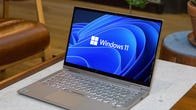Windows 11 vs. Windows 10: All the big differences

Windows 11 brings a lot more than just design changes. Keep your eye out for these upgrades.
Microsoft/Screenshot by Sarah Tew/CNET
Windows 11, the first major update to the Windows platform since Windows 10 launched in 2015, started to roll out Tuesday. Microsoft’s latest operating system offers a new interface and several features that bring Windows into a post-2020 world with more people working between their homes and the office. For existing Windows 10 users, Windows 11 will be available as a free upgrade — though the release will be staggered, and some PC users will not be able to install Windows 11 until mid-2022.
That’s assuming, of course, that your computer is compatible. (Find out if your PC will work with Windows 11 here.) If you still need to upgrade to Windows 10, don’t worry — a free Windows 10 download trick still works for many people. You may not even want to upgrade from Windows 10 to 11, and that’s OK. At least until 2025, when Microsoft says it will no longer support Windows 10.
Before you install the new OS, let’s go over the big changes Microsoft made and dig into what’s really different. Here’s everything that’s changed from Windows 10 to Windows 11. And make sure you check out our favorite Windows 11 features and how to use them — along with everything we wanted in Windows 11 but didn’t get and how to set your default search engine.
Read more: Windows 11 is coming, so does that mean I should wait to buy a new laptop?
Windows 10 vs. Windows 11: Every big difference in the new OS
Design and interface

Windows 11 features a new design with a centered Start menu and Taskbar.
Microsoft/Screenshot by Sarah Tew/CNET
Windows 11 brings a brand-new, more Mac-like interface to the OS. It features a clean design with rounded corners and pastel shades. The iconic Start menu also moves to the center of the screen along with the Taskbar. But you can move those back to the left, as they are in Windows 10, if you prefer.
Android app integration

You’ll be able to download Android apps to your PC in Windows 11.
Microsoft/Screenshot by Sarah Tew/CNET
Android apps will be coming to Windows 11 (though not right away) in Microsoft Store, via the Amazon Appstore. (There were a couple of ways to access Android apps on Windows 10, including if you had a Samsung Galaxy phone, but this will make it native.) This is something Windows users have been waiting for for years, and marks another move toward the merging of mobile and laptop devices.
Better virtual desktop support

You’ll find it easier to create and toggle between different virtual desktops in Windows 11 compared to Windows 10.
Microsoft/Screenshot by Sarah Tew/CNET
Windows 11 will let you set up virtual desktops in a way that’s more similar to Macs, toggling between multiple desktops at once for personal, work, school or gaming use. In Windows 10, this was harder to set up and use.
Easier transition from monitor to laptop

It’ll be easier to group different sets of windows and apps together and move between a desktop and a monitor thanks to Snap Layouts and Snap Groups.
Microsoft/Screenshot by Sarah Tew/CNET
The new OS includes features called Snap Groups and Snap Layouts — collections of the apps you’re using at once that sit in the taskbar, and can come up or be minimized at the same time for easier task switching. They also let you plug and unplug from a monitor more easily, without losing where your open windows are located.
Microsoft Teams added to the Taskbar

Microsoft Teams is built directly into the Taskbar in Windows 11 for easier video calling.
Microsoft/Screenshot by Sarah Tew/CNET
Teams is getting a facelift and will be integrated directly into the Windows 11 taskbar, making it easier to access (and a bit more like Apple’s FaceTime). You’ll be able to access teams from Windows, Mac, Android or iOS.
Widgets (well, sort of)

Launch widgets from the Taskbar in Windows 11 to see at-a-glance information on weather, news, stocks and more.
Microsoft/Screenshot by Josh Goldman/CNET
While they’ve been around for a while (remember desktop gadgets on Windows Vista?), including in a recent Windows 10 update, you can now access widgets directly from the Taskbar and personalize them to see whatever you’d like.
Enhanced touchscreen, voice and pen support

Microsoft is aiming to make Windows 11 easier to use on tablets than Windows 10.
Microsoft/Screenshot by Sarah Tew/CNET
For tablets, Microsoft has aimed to improve the experience for touch, with more space between icons on the taskbar, and adding gestures. Windows 11 also adds haptics to your digital pen, so you can hear and feel vibrations as you use it for taking notes or drawing. Finally, the OS introduces voice typing and commands across the system.
Xbox tech to improve gaming

Windows 11 brings some tech additions from the Xbox for better gaming.
Microsoft/Screenshot by Sarah Tew/CNET
Windows 11 will get certain features found in Xbox consoles, like Auto HDR and DirectStorage, to improve gaming on your Windows PC. This marks another move toward integrating PCs and Xbox consoles for Microsoft.
For more, check out everything we know about Windows 11 and how to download Windows 11.



-3.png?width=698&height=393&name=blog%20image%20Salima%20(1)-3.png)